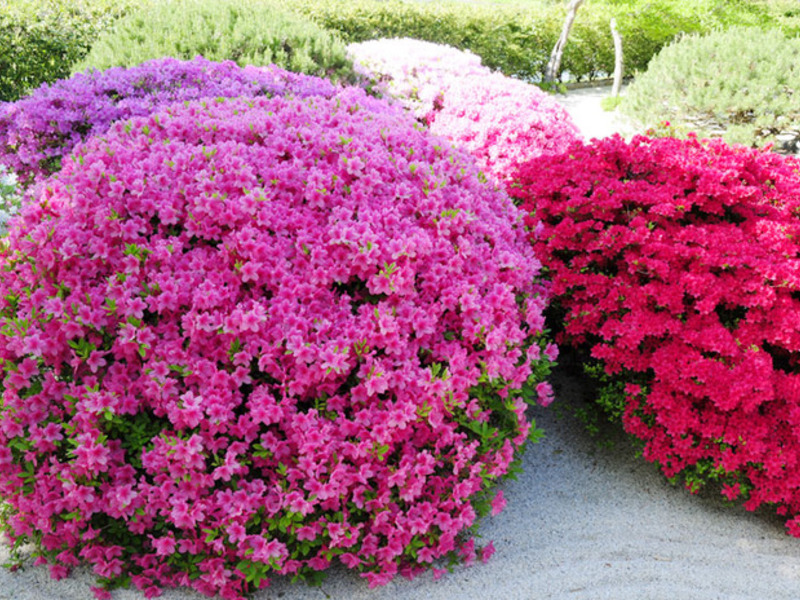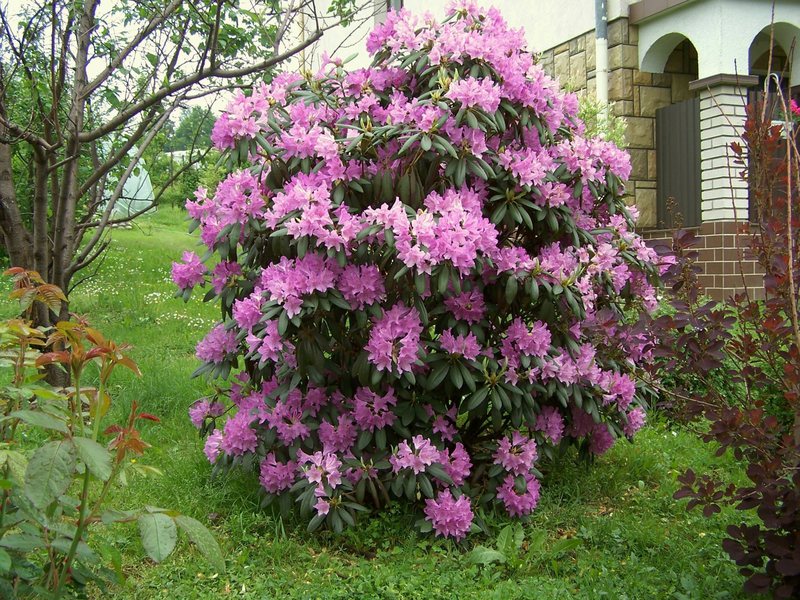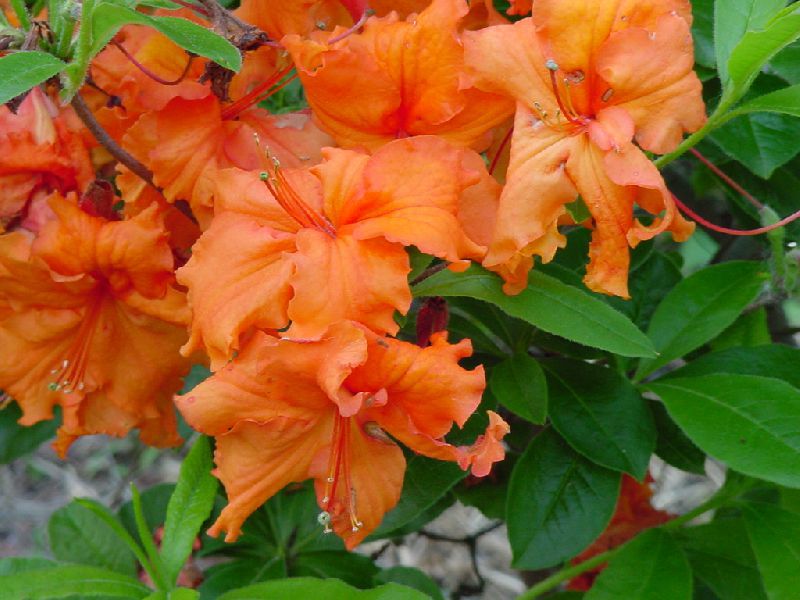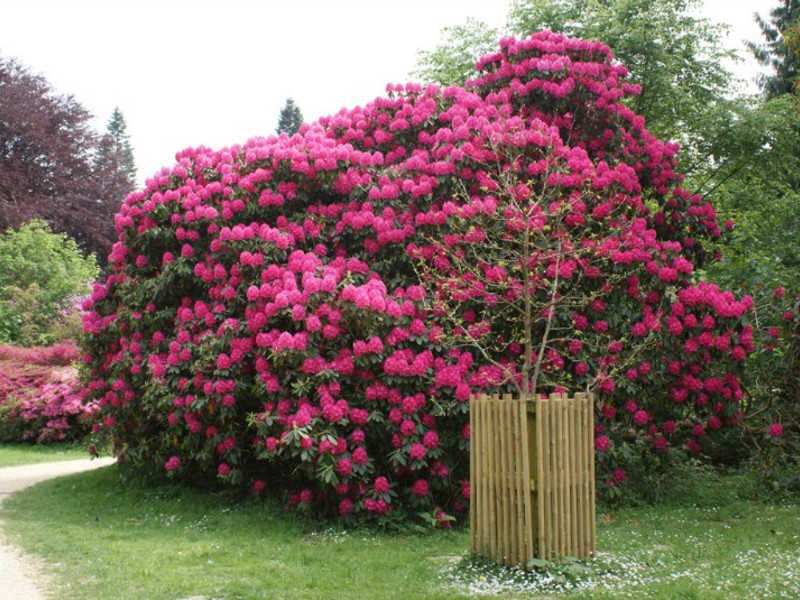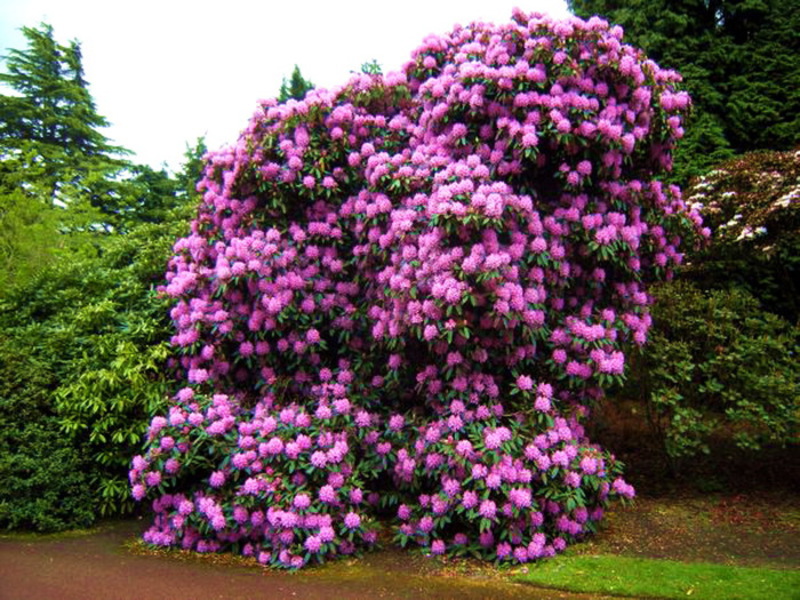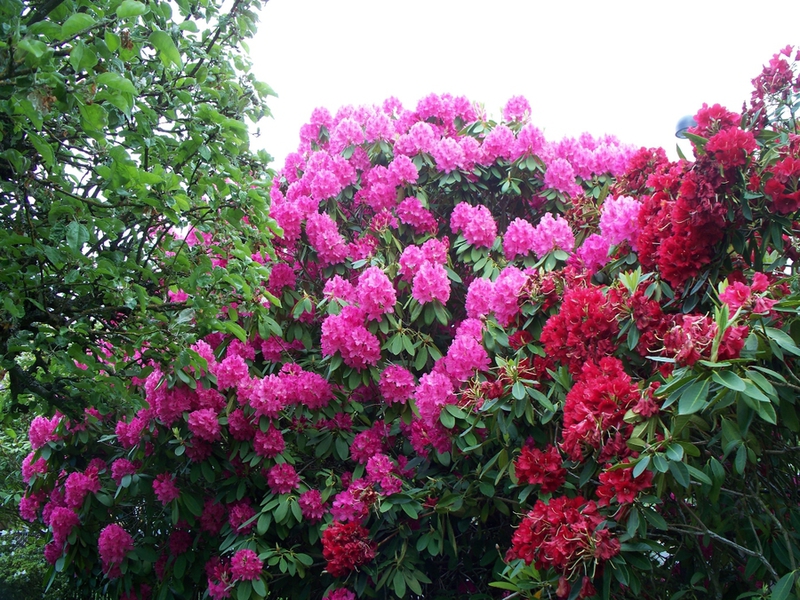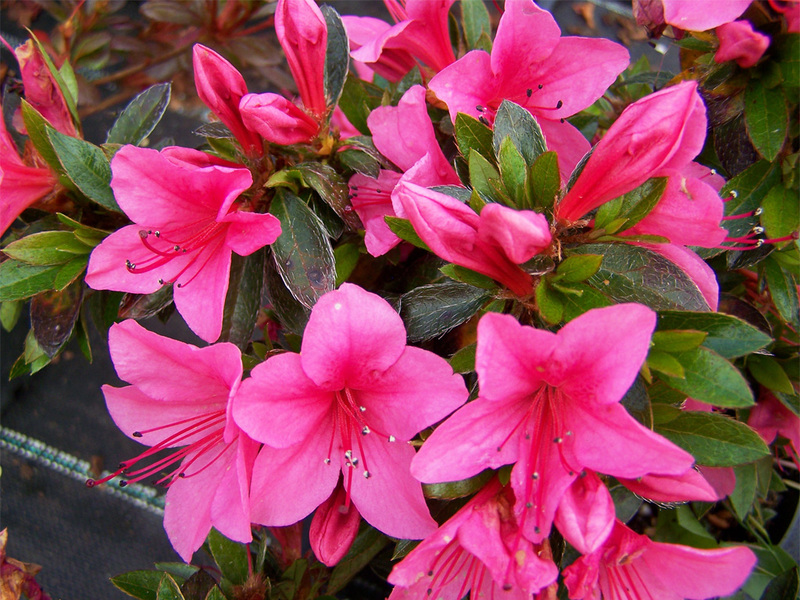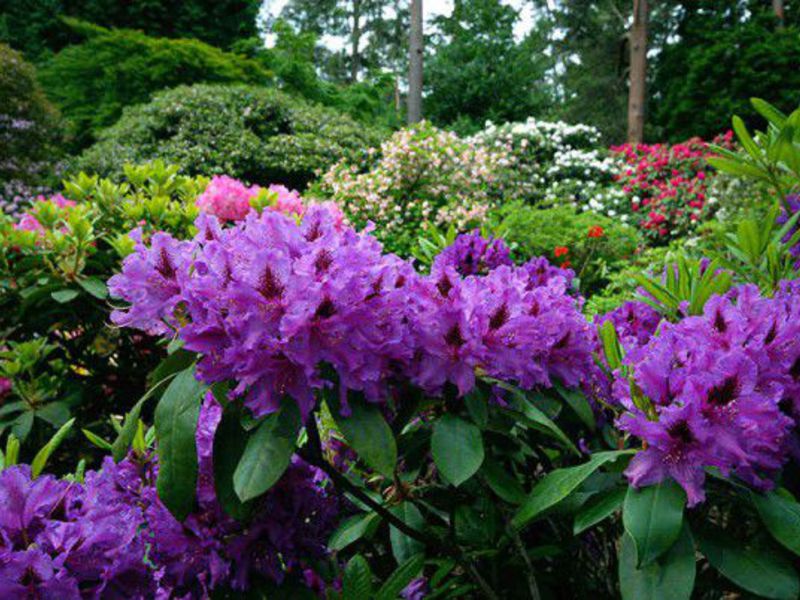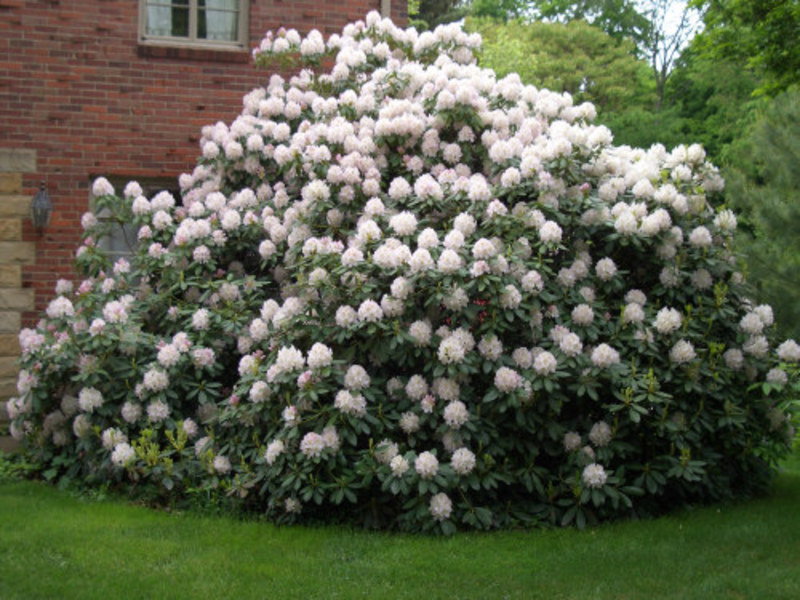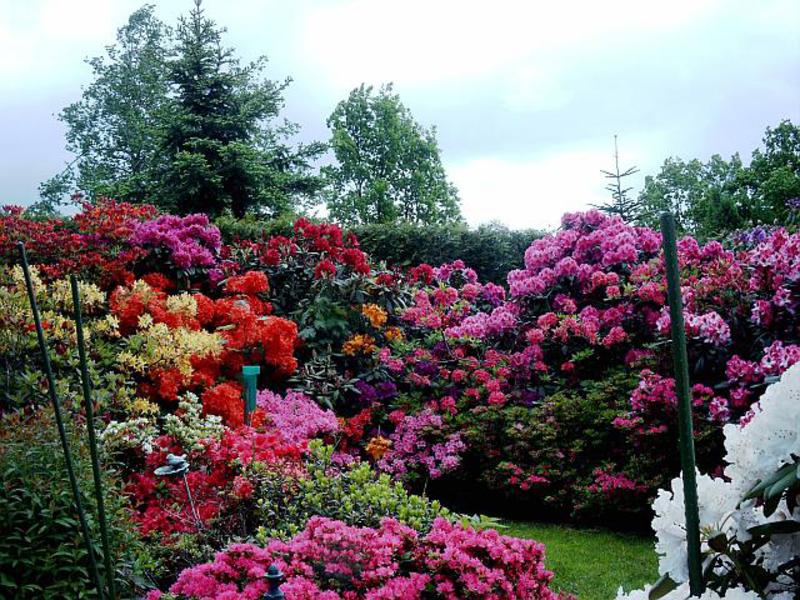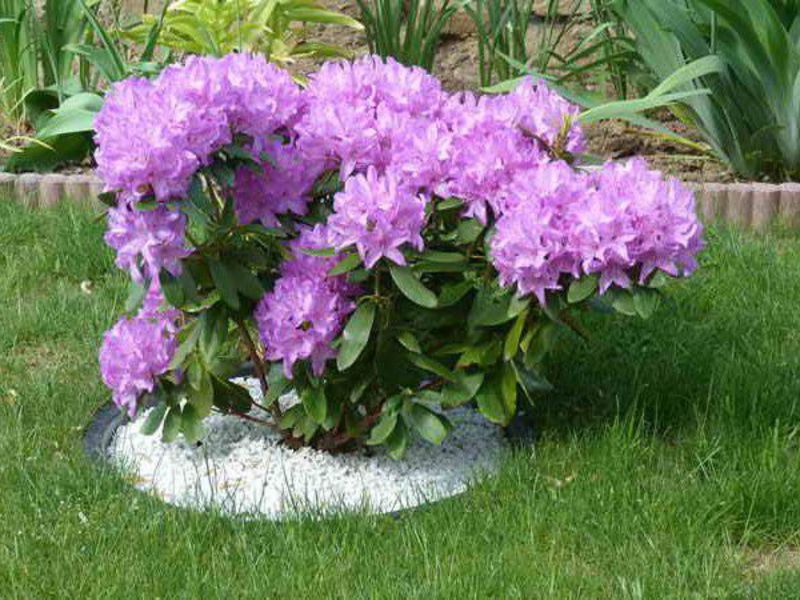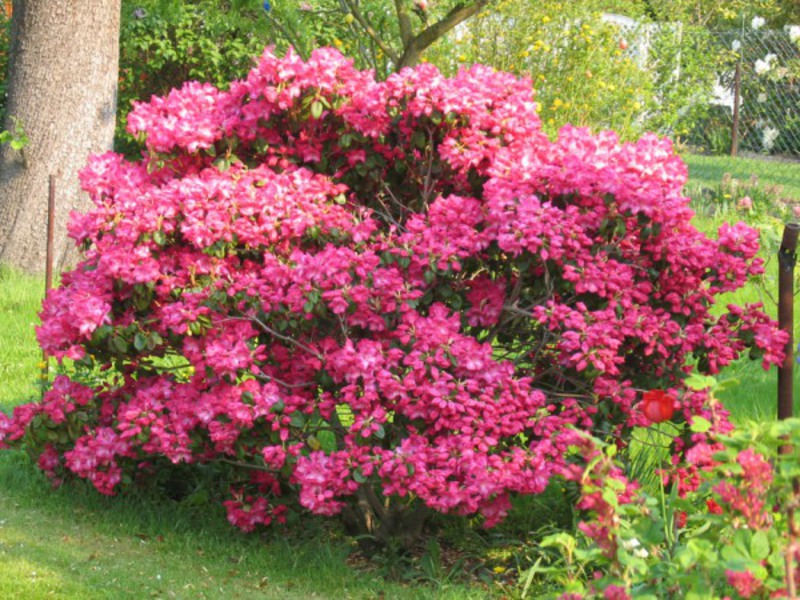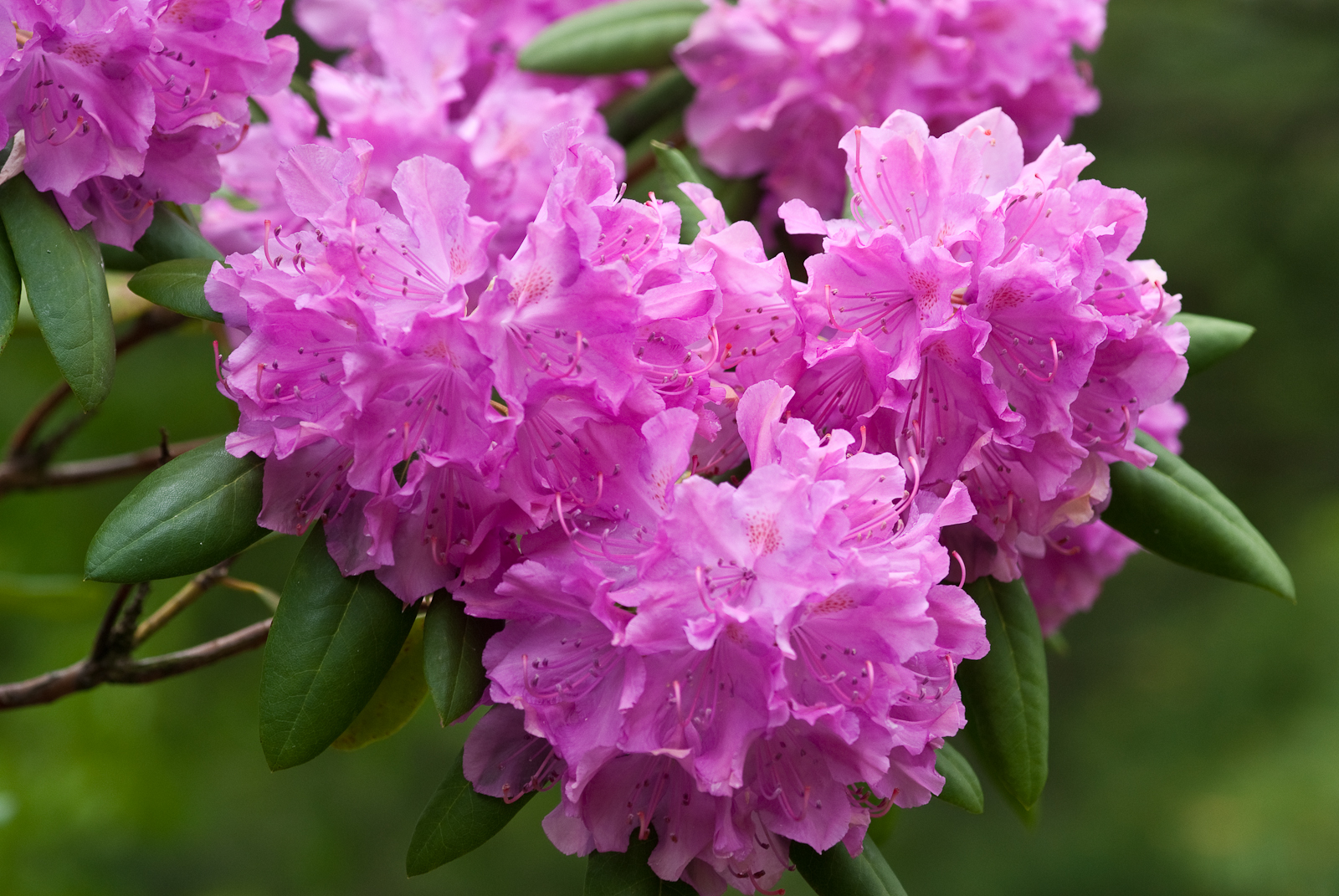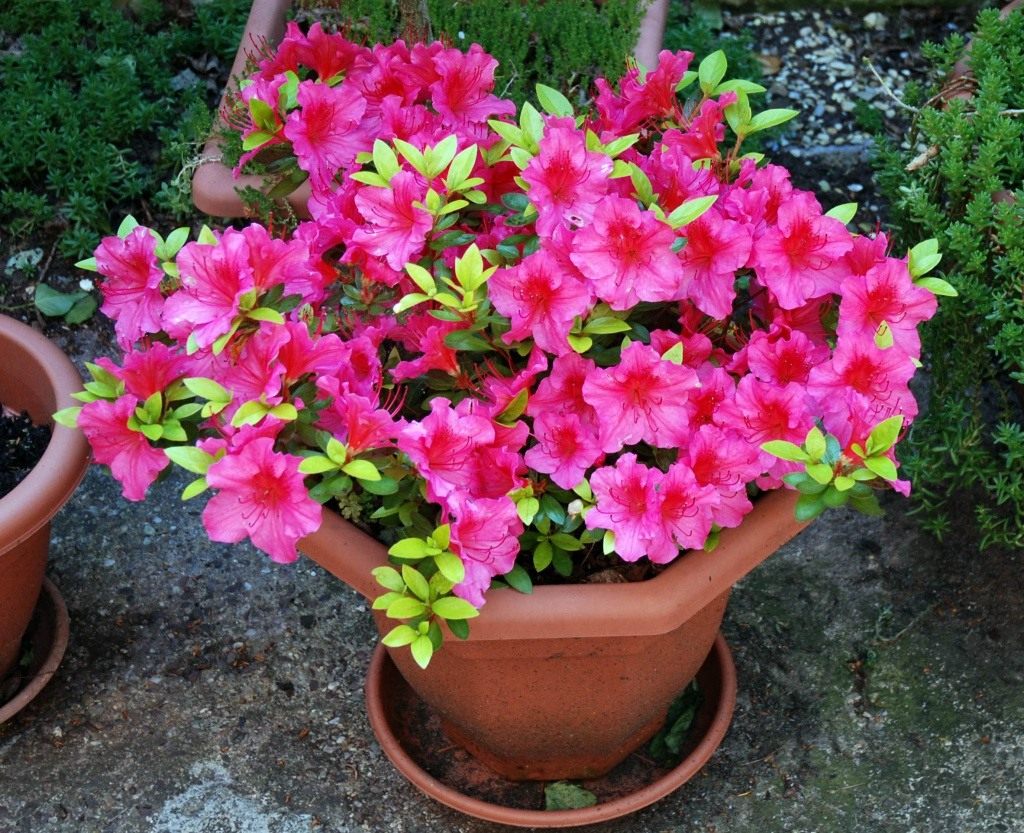Clouds of flowering bushes of delicate pastel and bright colors adorn any place, be it a park, alley, slopes of alpine hills or a garden in a private courtyard. The rhododendron plant belongs to the heather family, it was first grown by English homeowners, some call it an alpine rose in respect of the beautiful flower.
Russia allowed itself to be adorned with an airy and cloudy flower only in the 18th century. The harsh climate of the country scared off gardeners, but over time it became clear that the plant develops and grows without any problems if conditions for existence are created for it.
Content
Decorative compositions from rhododendron
Group landing
To decorate recreation areas, parks, alleys, planting flowers in a group arrangement, spectacular plants emphasize the edges of paths, lawns... The flower loves wet places, so rhododendrons are bred along the banks of artificial reservoirs in the Moscow region. Planting and maintenance is effortless and the park creates a stately ambience. The original enclosing borders are created by the mass of flowering plants.
When creating decorative groups, do not mix evergreen bushes with colored specimens. Tall plants are placed in the center of the composition, undersized species emphasize at the edges. A favorite design technique is the combination of conifers with bright rhododendrons. When decorating hills, hedges, they try to combine a variety of color shades, similar in scale. Purple, pink and white colors beautifully set off each other. The arrangement of yellow, orange and red bushes, which perfectly complements the interior, creates the feeling of a bright holiday. Photos of rhododendron flowers are shown below.
Single landings
Beautiful spreading bushes planted alone for decorating a lawn or highlighting a tall tree. Such a luxurious bush looks great near a bench, table, gazebo, breathing into the house. It is considered a good design technique to grow rhododendrons in separate large flowerpots or containers, which are moved around as needed to decorate different parts of the yard or garden.
The most common varieties of compact shrubs are grown in separate pots, for example, the Kusinsky rhododendron and various evergreen species. Some varieties are bred for industrial pruning, cut branches are stored for 20 days without losing the decorative effect.
Useful properties of the plant
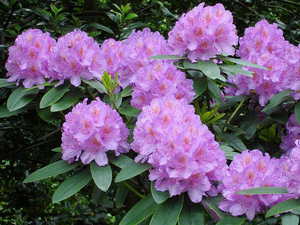 Some types of flowers are good for the human body. These include types:
Some types of flowers are good for the human body. These include types:
- Daursky;
- Caucasian;
- Golden;
- Yellow;
- Schlippenbach.
The high content of ascorbic acid in rhododendron leaves allows use decoctions of herbs when restoring immunity... But the leaves of the plant are used with caution, as they contain toxic substances that harm the human body. For the treatment of heart disease, vascular abnormalities, epilepsy, articular rheumatism, an infusion of a tablespoon of herbs in a glass of boiling water is prepared. This drug, with constant use, removes fluid from the body, normalizes the heartbeat, reduces shortness of breath, and helps to overcome colds.
Contraindications for taking the drug inside
There are some reasons for taking the drug. you cannot use the plant for medicinal purposes:
- the child's body does not tolerate drugs from the plant;
- pregnant women react badly to decoctions and flower infusions;
- people suffering from kidney disease and having necrotic changes in body tissues are treated by other means.
Before using medicinal infusions from rhododendron herb, they consult a doctor for consultation, even if the above deviations from the standard state are not visually detected.
Rhododendron cultivation technology
Planting soil
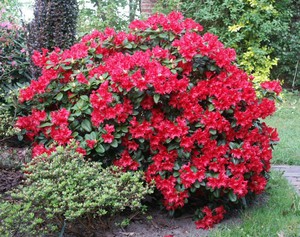 They begin to cultivate the flower in the spring, early planting in the ground gives the plant time for adaptation and rooting. If the variety has a closed root system, then the flower disembarks at a later time... To do this, prepare beds with acidic, loose soils, rich in humus. A mixture of peat, leafy earth, fallen needles is used as a substrate, mineral fertilizers are added. Photos of the plant can be viewed on the Internet.
They begin to cultivate the flower in the spring, early planting in the ground gives the plant time for adaptation and rooting. If the variety has a closed root system, then the flower disembarks at a later time... To do this, prepare beds with acidic, loose soils, rich in humus. A mixture of peat, leafy earth, fallen needles is used as a substrate, mineral fertilizers are added. Photos of the plant can be viewed on the Internet.
The plant is planted in pits up to 70 cm wide to 40 cm deep. In heavy clay soils, the plant is buried less, only 20 cm, while the hole expands to 1.2 m. Before that, the planting site is filled with peat or a substrate prepared in advance, the pH of which is 4.0-5.0. mixtures are recommended for growing:
- acidic peat, soil with needles and foliage, coastal sand in a ratio of 3: 3: 1;
- sawdust, sour peat, river sand in a solution of 1: 2: 1;
- sour peat, caked needles, sawdust, river sand in a 2: 1: 1: 1 consistency.
All mixtures are enriched with mineral fertilizers (170-220 g per cubic meter), sulfur is added to them in an amount of 50-60 years. If the acidity of the soil is insufficient, then it is acidified with undiluted sulfuric acid, which is added in an amount of 1 ml per 10 liters of water. Acetic, citric, oxalic and other acids are used (4 g per 10 l of liquid).
As an oxidant, the use of electrolyte from batteries is justified, which is added in an amount of 20 ml per 10 liters of water. In addition to acid, the electrolyte contains sulfur, which additionally enriches the soil. Do not plant plants in pure peat or a mixture of peat and needles. This mix is a poor conductor of moisture to the root system. Before planting in the soil, the lower part of the plant is placed in a vessel with water and wait a while until air bubbles stop rising to the surface, after this procedure the bush is ready for planting.
Drop off location
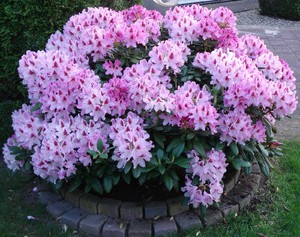 Representatives of the varieties Yellow, Japanese, Schlippenbach in the strong sun in the middle and southern regions are burnt, therefore they are covered with shields from the side of direct rays. Varieties that are resistant to heat, but afraid of the wind - Sticky, Pink and Canadian after summer, in the beginning of autumn must be protected by artificially constructed huts from piercing currents of cold air. The optimal place for planting bushes of the plant is the northeastern and northern surfaces of the slopes in Russia and Ukraine.
Representatives of the varieties Yellow, Japanese, Schlippenbach in the strong sun in the middle and southern regions are burnt, therefore they are covered with shields from the side of direct rays. Varieties that are resistant to heat, but afraid of the wind - Sticky, Pink and Canadian after summer, in the beginning of autumn must be protected by artificially constructed huts from piercing currents of cold air. The optimal place for planting bushes of the plant is the northeastern and northern surfaces of the slopes in Russia and Ukraine.
In the northern conditions of a harsh winter, they are planted frost-resistant plant varieties: Sharp, Ledebura, Daursky, Sikhotinsky, capable of transferring temperatures up to 40 degrees below zero without freezing.
It is impossible to place rhododendron next to growing lindens, maples, chestnuts, birches, willows, such plantings have a detrimental effect on the development of flowers.These trees actively suck out moisture from the soil, the bush, not receiving enough moisture, will die. The optimal is the neighborhood of coniferous plantations or fruit-bearing trees, but their crowns should not shade the rhododendron.
Flowers grow well in moist soils, but excess moisture, for example, in swampy areas, is removed using a drainage system. Bushes are planted in high beds if there is a threat of spring flooding and partial flooding of the site. The rise above the liquid level should be at least 15 cm, the edges of the beds are fixed with stones, among which flowering bushes look very picturesque.
Caring for care
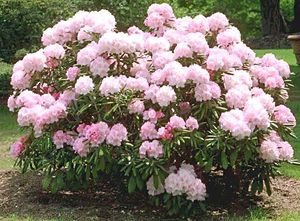 If the planting is done technologically correctly, then caring for the plant will not be difficult. The main one is ensuring proper watering... Soft water is used, without a large amount of dissolved salts. The weeds around the bush are removed carefully, they are pulled out. Cultivating tools are not used so as not to damage nearby roots.
If the planting is done technologically correctly, then caring for the plant will not be difficult. The main one is ensuring proper watering... Soft water is used, without a large amount of dissolved salts. The weeds around the bush are removed carefully, they are pulled out. Cultivating tools are not used so as not to damage nearby roots.
The bush is fed in May, June, solutions of liquid mineral fertilizers intended for this type of plants are used for irrigation. It is effective to use the popular top dressing Kemira-universal, the dry granules of which are placed under the bush. At the end of the feeding season, in the last decade of June, the plant is watered with a prepared potassium sulfate solution. To a bucket of water at room temperature a tablespoon of fertilizer dissolves... This amount is enough for watering a square meter of the planting area of young plants. Adult plants are watered with water with 2 tbsp dissolved in it. l. potassium sulfate. This ends the fertilization period.
Pruning the rhododendron to improve cultivation is optional, but it is done to create a decorative bush shape immediately after flowering begins. In early June, they get rid of unnecessary root shoots and too elongated shoots, in the process of leaving, dried and damaged branches of the plant are cut off. Ornamental pruning of the bush delays the period of appearance of the first flowers, and slows down the growth somewhat. Fast-growing species tolerate pruning best. Faded buds the plants are removed, preserving the axillary buds, the operation accelerates growth and maintains a lush flowering in subsequent years.
Irrigation water quality
The natural wet conditions in the highlands suggest that the plant loves spraying a bush with leaves and flowers. Watering the rhododendron should be done carefully, but in moderation. An important role is played by the acidity of irrigation water, which does not exceed 4-5. River water at room temperature or collected moisture after rain is well suited for these purposes. Using artesian or tap liquid enriched with magnesium and calcium salts will gradually clog the soil and the bushes will lose their attractive appearance.
So that the rhododendron develops and pleases the eye with a beautiful flowering, use acidified water for irrigation:
- citric acid is diluted in an amount of 3-4 grams per 10 liters of water;
- half a glass of vinegar is diluted in a bucket of water;
The intensity of watering is increased during the flowering period. In dry autumn without rains, the plant is watered abundantly, which will be a decisive factor for a good wintering. In dry and hot summer weather, rhododendron is sprayed with drip irrigation, trying to prevent the sun's rays from falling on the leaves at this time.
Reproduction of bushes
 A very unpretentious plant in terms of reproduction, it is performed by seeds, branches, grafting, dividing, cuttings. The seeds of a plant are sown on the surface of the soil, if it falls to a depth of even a centimeter, then the plant will not grow. Shoots appear on the bush in 12-20 days, which depends on the variety of seeds, which differ in different rates of rise and germination.
A very unpretentious plant in terms of reproduction, it is performed by seeds, branches, grafting, dividing, cuttings. The seeds of a plant are sown on the surface of the soil, if it falls to a depth of even a centimeter, then the plant will not grow. Shoots appear on the bush in 12-20 days, which depends on the variety of seeds, which differ in different rates of rise and germination.
After the appearance of shoots, the seedlings are transplanted into separate containers, drainage is performed to the root system for constant access of air.Watering is carried out through a mesh or by spraying, subsequently covered with glass vessels to maintain soil moisture in room conditions. Glass caps are removed several times a day to prevent decay. Containers with seedlings are placed in a bright place, but without hitting the scorching sunlight. During the first year of growth, the seedlings rise up to 5 cm in height, some varieties give branching.
Long-awaited flowering starts 3-10 years after planting, the time of bud appearance depends on the variety. If we talk about vegetative division, then flowering is observed already in the second - third year, the root system of cuttings develops in 1.5-2 months. Rooting of cuttings and active growth is ensured by proper watering, spraying, heating and care. The transplant of developed cuttings is carried out in the autumn. Cuttings overwinter at room temperature of about 5 ° C, for example, in closed verandas or greenhouses.
In the spring they dive in the soil, using the land familiar to rhododendrons. Cutting gives a small number of bushes, and a limited amount is obtained when dividing a bush. Therefore, if you want to decorate a large surface of a garden or park, then propagation with seeds is preferable. After the grafting of the plant on one bush, you can often see blossoming flowers of different shades.
Wintering plants
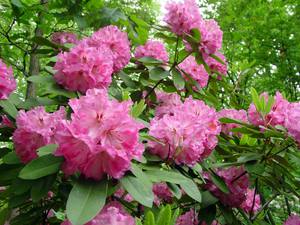 Some deciduous species of rhododendron referred to as winter-hardy varieties and do not require additional shelter for the winter. Wrap up only the neck of the bush. Evergreen rhododendrons cover, in winter they do not freeze so much as dry up, therefore they require protection from the wind and sun. The plants are opened after warming up and thawing the soil.
Some deciduous species of rhododendron referred to as winter-hardy varieties and do not require additional shelter for the winter. Wrap up only the neck of the bush. Evergreen rhododendrons cover, in winter they do not freeze so much as dry up, therefore they require protection from the wind and sun. The plants are opened after warming up and thawing the soil.
To decorate a small private yard, developed bushes are purchased in the store, which root well and bring joy with flowering in the first year.
